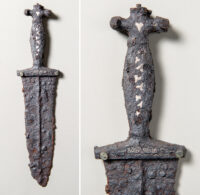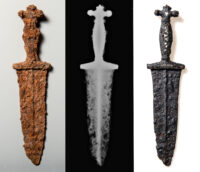 A Roman dagger discovered near the village of Tiefencastel in the Alpine canton of Graubünden has been restored revealing rich decoration of inlaid silver and brass. Its cross-shaped handle dates it to 50 B.C., an extremely rare type of which only four examples are known.
A Roman dagger discovered near the village of Tiefencastel in the Alpine canton of Graubünden has been restored revealing rich decoration of inlaid silver and brass. Its cross-shaped handle dates it to 50 B.C., an extremely rare type of which only four examples are known.
The pugio was found in May 2019 by metal detectorist Lucas Schmid who volunteers to employ his hobby on behalf of the Archaeological Service of Graubünden (ADG). He was scanning an area of the Crap Ses Gorge in the Oberhalbstein Alps where Roman legions battled the Rhaeti in 15 B.C. and established a summer military camp to control the Septimer Pass. Roman lead sling bullets and weapons have been discovered there since 2003.
 Schmid found the heavily corroded dagger a foot beneath the surface. It was complete, albeit missing its scabbard. next to a gladius, the short double-edged sword that was standard issue for Roman legionaries and local auxiliaries. He alerted the ADG to his finds and archaeologists followed up with an excavation at the site this September. In one month, the team unearthed hundreds of military artifacts, including hobnails from caligae, coins, fragments of shields, lead sling bullets and spearheads.
Schmid found the heavily corroded dagger a foot beneath the surface. It was complete, albeit missing its scabbard. next to a gladius, the short double-edged sword that was standard issue for Roman legionaries and local auxiliaries. He alerted the ADG to his finds and archaeologists followed up with an excavation at the site this September. In one month, the team unearthed hundreds of military artifacts, including hobnails from caligae, coins, fragments of shields, lead sling bullets and spearheads.
“It is not only the outstanding individual objects such as the dagger (a pugio) that are interesting, but also the large number and composition of the found objects,” study team member Peter-Andrew Schwarz, an archaeologist at the University of Basel, told Live Science in an email.
The slingshots are marked with the letters that show which Roman legion made them, — while the shoe nails and some other weapons, including some of the spearheads, are clearly also of Roman origin, he said.
The archaeologists have also unearthed fragments of swords, parts of shields and spearheads that were part of the armament of the opposing Rhaetians, he said.
The significance of the discoveries has spurred the ADG to launch a five-year investigation of the site that will culminate in an exhibition of the finds. The Canton of Graubünden has made a series of three short videos documenting the restoration of the dagger. It’s in German and has no subtitles, alas, but it’s cool to see the process even if you can’t understand what is being said.
The metal detectorist found it in May 2019 and archaeologists didn’t start work on the site until September 2021? Why did it take them 28 months to follow up a discovery such as this?
Richard, for Switzerland, a figure of 28 month is not bad at all :yes:
That three part mini video series is indeed to be highly recommended.
———
–Ista video series est omnis divisa in partes tres!– 🙆️
———
The first part explains, how and where it was found, what it is, and puts up the question if this is to be dated 15BC, or might be otherwise older (~50BC). The 2nd part explains the conservation, its desalination, and why it is necessary, but also what is underneath the crust. Notably, the conservationist is the only one without any swiss accent. Finally, the 3rd part returns to the find site, taking a closer inspection at the spot itself, and argues what the next piece in the puzzle might be, in order to fully explain what actually had happened.
cf. en.wikipedia.org/wiki/Rhaeti#Roman_conquest
They also point out that the “ancient Rhaetic language is not to be confused with the modern Romance languages of the same Alpine region, known as Rhaeto-Romance” – en.wikipedia.org/wiki/Rhaeto-Romance#Geographic_distribution
On a side note 😮
Arguably, Publius Quinctilius Varus was Legate of the Nineteenth Legion –as one of the three Legions, together with the 17th and 18th– that were butchered in 9AD– and -if so- had in 15BC taken part in subjugating the Rhaeti.
Between 15BC and 9BC, he could have been commander in the garrison in Dangstetten, in what today is Waldshut county, close to the Swiss border, where a lead pendant was found, inscribed with “Pri(vat)tus caloni(bus) ser(vus) P(ublii) Q(uinctilii) Vari leg(ati) L(egionis) XIX c(o)h(ortis) I – Privatus from the baggage train servants, Slave of Publius Quinctilius Varus, the Legate of the 19. Legion, 1. cohort.”.
In 7AD, Augustus made him the first “officially appointed” governor of the newly created Roman province of Germania, while Marbod moved his people eastwards into what today is Bohemia. The guy that the Romans referred to as “Arminius” sent Varus’ severed and pickled head to Bohemia, as an offer to join forces, but apparently Marbod instead forwarded the head back to Augustus – “Quinctilius Varus, give me back my Legions!” (Quintili Vare, legiones redde!).
Basically, it should be possible to tell if the finds were lost during battle, or alternatively “deposited” afterwards.
:hattip:
———
en.wikisource.org/wiki/The_Annals_(Tacitus)/Book_1#61
en.wikisource.org/wiki/The_Annals_(Tacitus)/Book_1#62
en.wikisource.org/wiki/The_Annals_(Tacitus)/Book_1#63
en.wikipedia.org/wiki/Kalkriese
SSSSSSSSSSSSSSSSSSSSSSSSSSSSSSSSSLLLLLLLLLLLLLLLLLLLLLLLLLLLLLLLLLLLLLLLLAAAAAAAAAAAAAAAAAAAAAAAAAAAAAAAYYYYYYYYYYYYYYYYYYYYYYYYYYYYYYYYYYYYYYYYYYY!!!!!!!!!!!!!!!!!!!!!!!!!!!!!!!!!!!!!!!!!!!!!!!!!!!!!!!!!!!!!!!!!!!!!!!!!!!!!!!!!!!!!!!!!!!!!!!!!!!!!!!!!!!!!!!!!!!!!!!!!!!!!!!!!!!!!!!!!!!!!!!!!!!!!!!!!!!!!!!!!!!!!!!!!!!!!!!!!!!!!!!!!!!!!!!!!!!!!!!!!!!!!!!!!!!!!!!!!!!!!!!!!!!!!!!!!!!!!!!!!!!!!!!!!!!!!!!!!!!!!!!!!!!!!!!!!!!!!!!!!!!!!!!!!!!!!!!!!!!!!!!!!!!!!!!!!!!!!!!!!!!!!!!!!!!!!!!!!!!!!!!!!